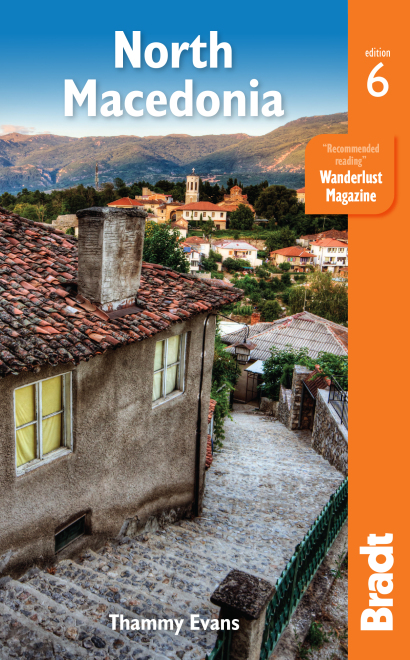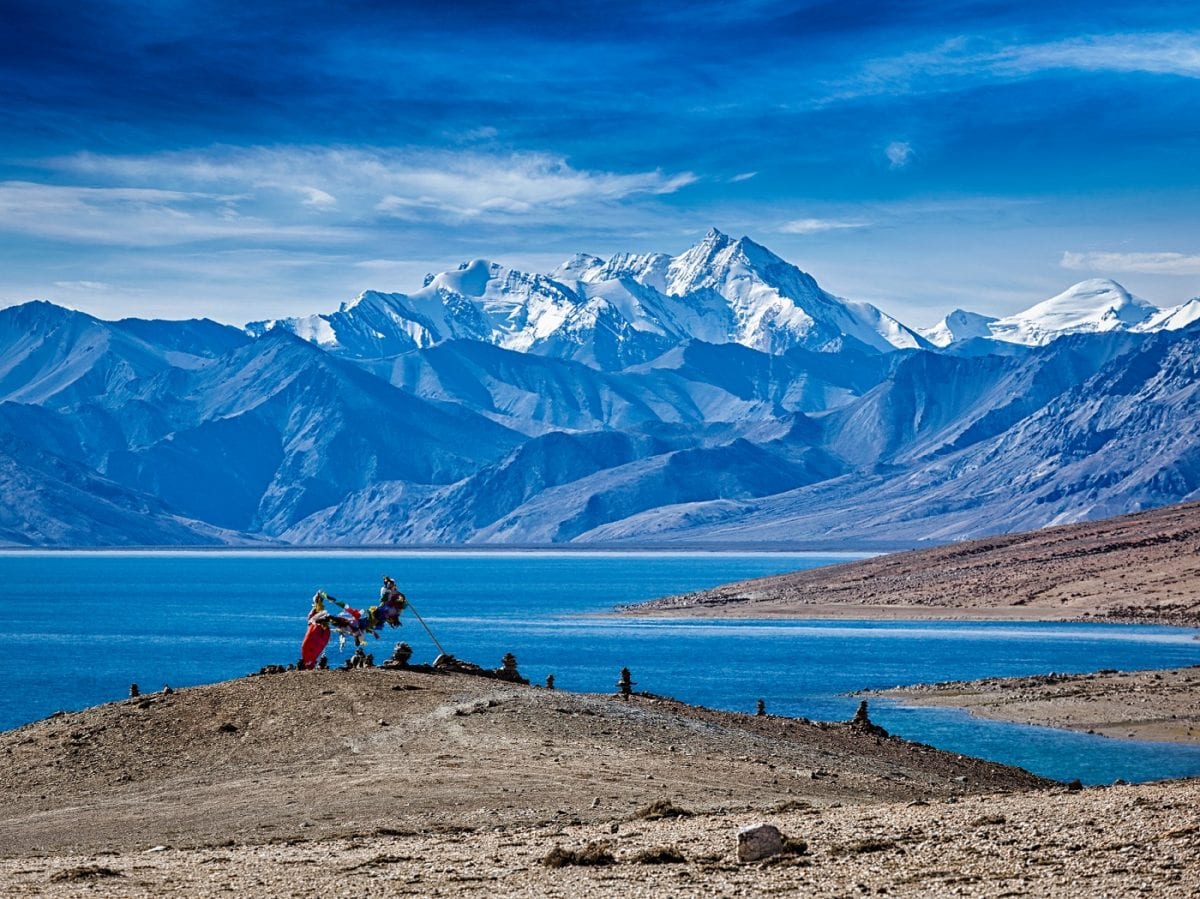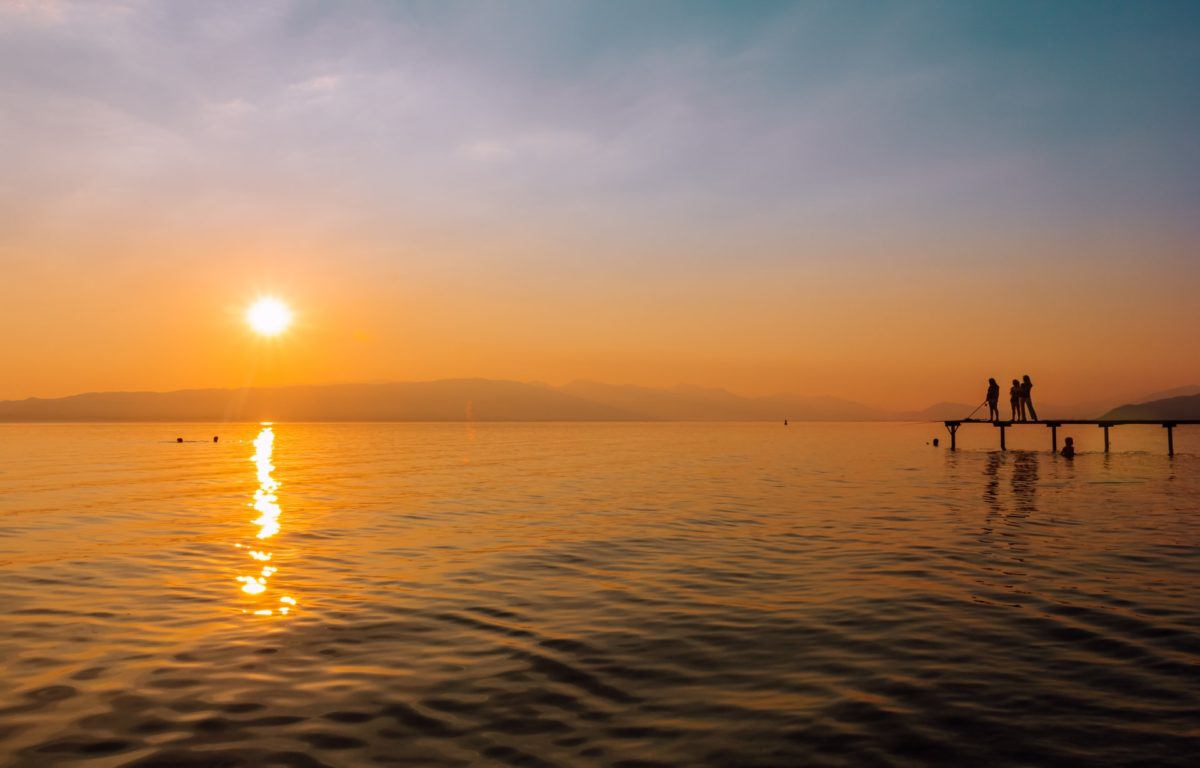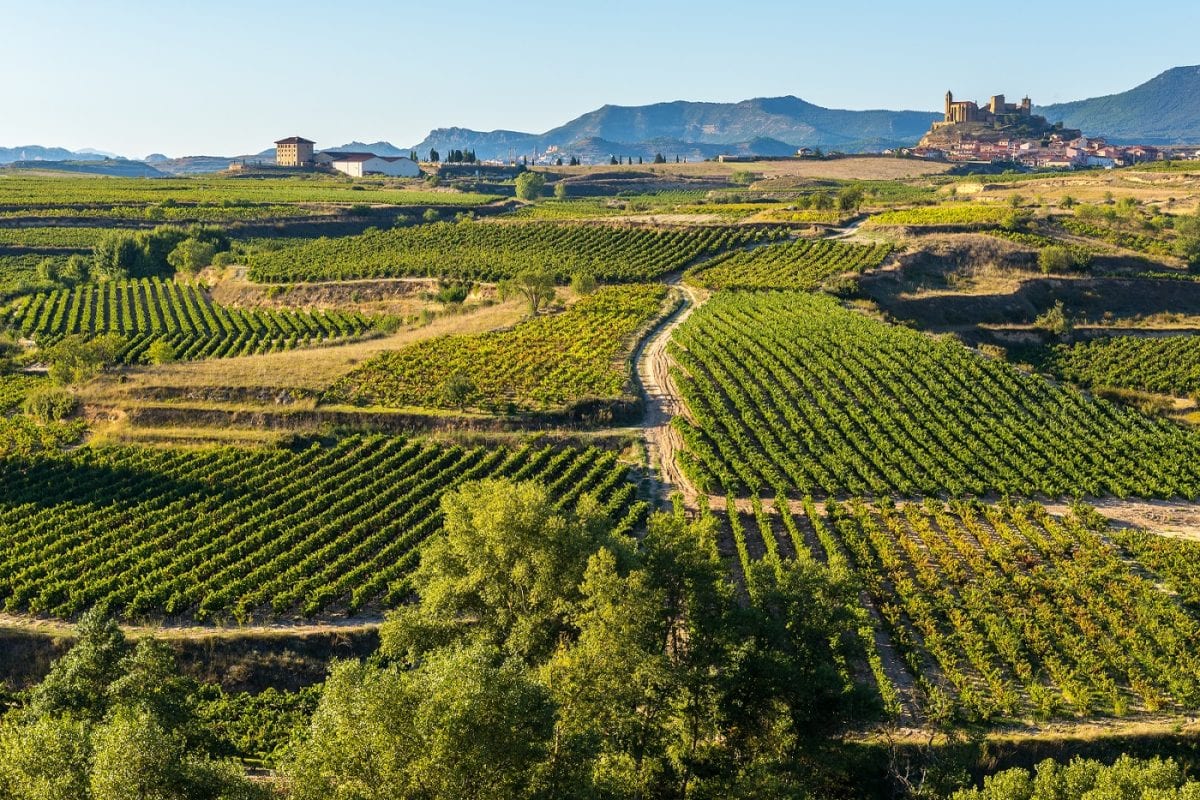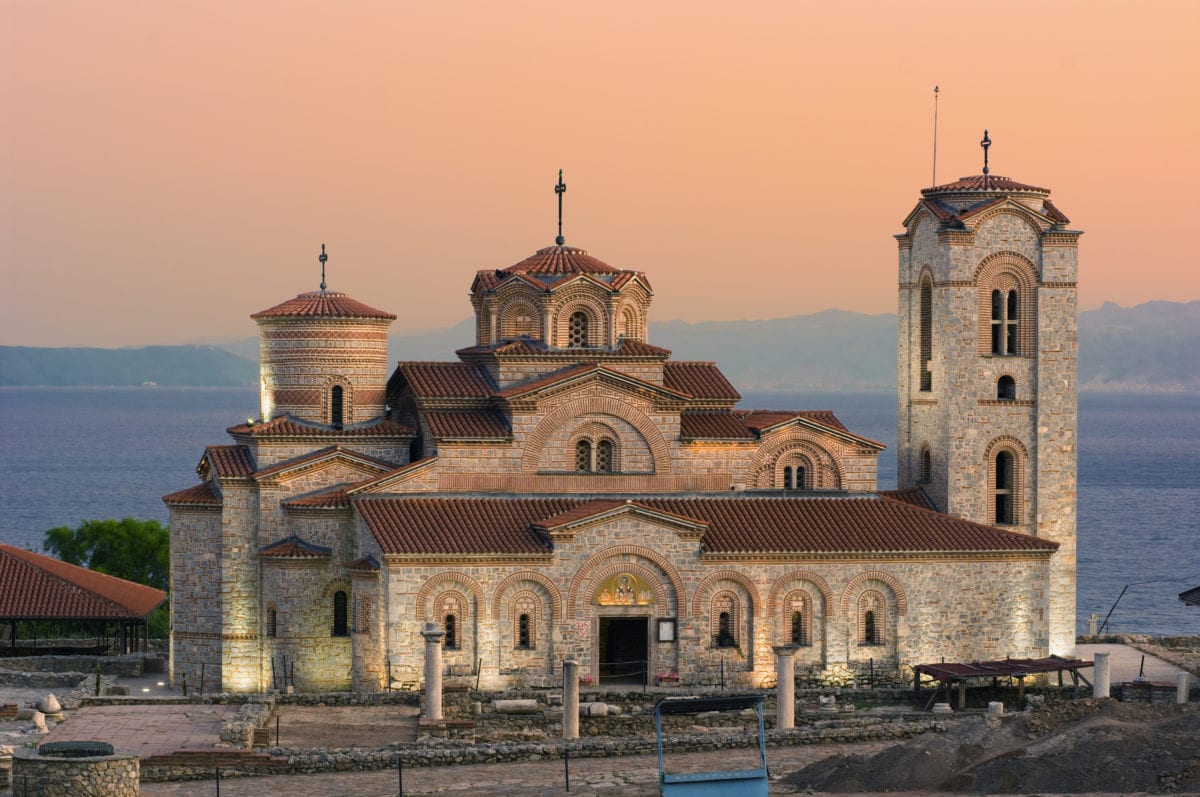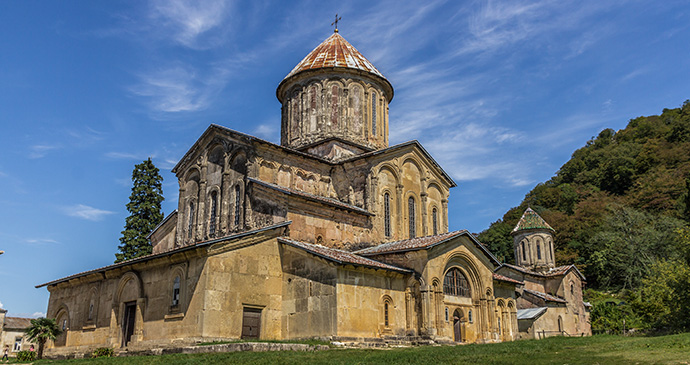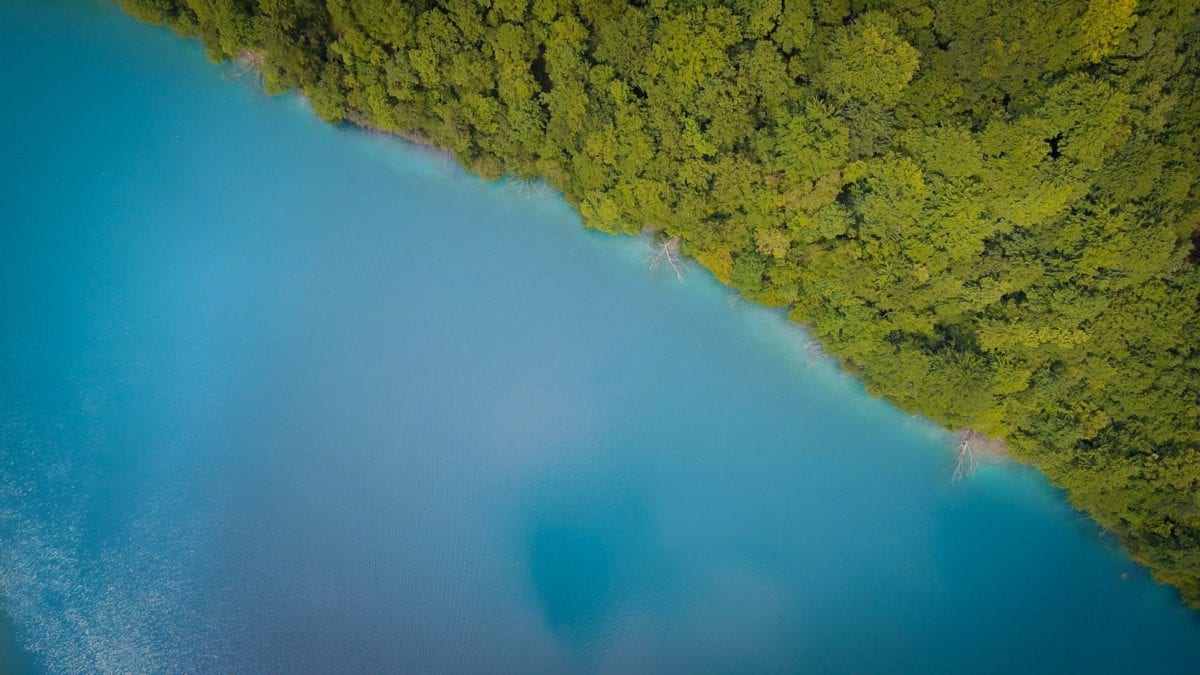Geographically and historically there is much more to North Macedonia if you veer off the tarred and hardened road, and you will only ever be rewarded for taking the bumpy side track.
Thammy Evans, author of North Macedonia: the Bradt Guide
Long buffeted by the struggles of the Balkan Peninsula, North Macedonia is emerging as one of the most entrancing corners of Europe. A captivating blend of the ancient and the brand new, the country’s crumbling mountain monasteries and rustic hostelries are as much a part of its charm as its excessive new monuments and nascent boutique vineyards.
Sip heady cocktails beside the crystal-clear waters of Lake Ohrid, immerse yourself in Skopje’s burgeoning café culture or discover the hidden hot springs dotted around the country, all of which make North Macedonia a traveller’s tale like no other and worth more than just a pit-stop on a trip to somewhere else.
Food and drink in North Macedonia
Food
Macedonian cuisine combines simple, healthy, Mediterranean cooking with centuries of spicy Ottoman influence. It is a celebration of fresh, organic, small-scale produce, and its wine is traditionally made with no sulphites. Summer markets teem with good local fruit and vegetables, while the winter holds crisp pickles (turšija) and jars of tasty red pepper spreads. Restaurants are getting better at offering some of the delicious domašni (home-style) dishes, but outside the main towns simple restaurants might only serve grilled chicken breast or pork chops and a few basic side dishes. Like most of continental Europe, Macedonians have a tradition of going out to eat, and with their children. So you’ll find many places (fewer in Skopje) are very child friendly.
Macedonian meze (from the Turkish, and ultimately Persian maze; also known as ordever, literally ‘hors d’oeuvre’) is the best-kept secret of Macedonian cuisine. Usually served at the start of a banquet, meze is so tasty and varied that it can make a whole meal on its own. The Macedonian meze are a variety of cold ‘creamed’ vegetable spreads, initially cooked till soft and then hand blended with herbs and spices, onions and garlic, and doused with not too much oil. The most common are ajvar, pindžur (roasted aubergine and peppers), tarator (yoghurt, cucumber, walnuts and garlic), kajmak (a type of clotted cream, often mixed with hot chillis and potatoes), egg and mushroom, and sweet grilled red peppers doused in garlic and oil (the latter usually only available in late summer). Eaten with pitta bread, sarma (stuffed vine leaves), local cured ham, Parmesan and a strong local drink like mastika or rakija, it is a real treat.
The most famous of these meze is ajvar, made every autumn when red peppers are at their most abundant. The best, of course, is homemade (domašni). To be invited into a Macedonian home to make ajvar is quite a privilege (some say it is like being offered the possibility of citizenship), and will give you an idea of the meticulous preparation that must go into preparing this Macedonian speciality.
The main fare of any Macedonian meal is either meat or freshwater fish. Lamb is the most expensive and therefore not often served in cheaper restaurants. It comes roasted either in the oven or on a spit, and served in a big chunk on your plate, usually without rosemary, never mind mint. Otherwise the staple meat dish for most Macedonians is skara: plain grilled pork or chicken, usually salted and basted. Skara is so popular that you can buy it from street stalls by the kilo! Veal (teleško meso), beef, eel (jagula), stroganoff, thinly sliced garlic liver (džigr), schnitzel, fresh pork ribs (svježe rebra), pork chops (kremenadle) and skewered kebabs (ražnič) are also prolific. Kebapči are an extremely popular form of skara, a Balkan speciality of small sausage-shaped burger meat, well seasoned and very tasty with a beer and some good bread. Other popular traditional meat dishes are stuffed peppers, pork knee joint and selsko meso (village meat), which is a stew of different meats and sausages in an earthenware pot. Makedonsko meso is a variation of this with North Macedonia’s famous capsicum peppers.
Freshwater fish, either trout or carp (krap in Macedonian), is abundant in North Macedonia. Ohrid is most famous for its letnica and belvica trout, and Dojran for its native carp. These particular fish varieties are peculiar to the lakes and cannot be found outside North Macedonia, and for this reason (among others) Ohrid is protected under UNESCO. Sadly, Ohrid trout, which has been caught in the past at over 20kg in weight, has been over-fished and this is not helped on the Albanian side of the border by lakeside boys selling trout by the bucketful. You may, therefore, want to think twice before partaking too often of this famous and increasingly rare Ohrid dish. It is now illegal to fish for Ohrid trout.
Fresh salads in North Macedonia, especially outside Skopje, are not very inventive. Your four main choices are a green salad (lettuce); a mixed salad (cucumber, tomato, grated cabbage and carrot); a Šopska salad (cucumber, tomato and grated white goat’s cheese); and Greek salad (cucumber, tomato, cubes of feta cheese and maybe some olives). Vinaigrettes and salad dressings are almost unheard of, so don’t expect a choice of thousand island dressing, blue cheese or ranch, or even salad cream. There is usually olive oil and vinegar served alongside and balsamic vinegar available in Skopje.
The art of breakfast is slowly coming to North Macedonia and traditionally consists of a strong coffee before work possibly with bread and cheese or jam, and at the weekends juvki or tarama (a cereal-based baked dish), then a break at around ten for a gevrek or kifla (sesame bread ring) and plain drinking yoghurt or ajran before settling down for a long lunch around 14.00. In Skopje, bakeries serving delicious pastries are becoming common, but outside the capital it is wise to make sure you have breakfast included in your hotel bill, or buy something in, as you’ll find few places on the streets that will serve you anything to eat. In Ohrid you can get sweet and savoury muffins, including proja (corn muffin with spinach) at Dva Biseri café from 08.00 in the morning.
If you’re a vegetarian, travelling in North Macedonia need not be too difficult although you’ll probably have had enough of meze, turlitava, tavče gravče and pohovani kromid (breaded onions) by the end of your stay. If you’re a coeliac, then your time might be more difficult as rice dishes and chips are usually served everywhere. You might want to make sure you ask for everything bez leb in order to avoid the waste of ubiquitous bread.
Drink
The preferred drink in North Macedonia is coffee, either the strong Turkish variety which is a challenge to drink without sugar, served in espresso-size cups, or the usual cappucinos, machiattos and espressos. Turkish tea, served in small glasses, is popular in Albanian areas, and you’ll sometimes see servers on bicycles or rollerblades carrying trays of them through the streets to customers. Fruit tea is usually considered a drink for the sick, but don’t be deterred! North Macedonia has lots of fruit teas (ovošen čaj) and mint tea (čaj od nane), and their mountain tea (planinski čaj) is a refreshing drink served in all the mountain huts and many restaurants. Majčina dušica (mother’s little soul) tea is also a very popular tea of wild thyme. And beware the hot chocolate – it is often a filling warm chocolate mousse served in a cup!
Salep, a drink made of ground wild orchid root and hot milk, is of Turkish origin and usually served with a sprinkling of ground cinnamon. You won’t find it everywhere, but it’s very tasty and warming on a cold winter’s day. Another Turkish drink plentiful in B vitamins and carbohydrates is boza, a thick tart drink made from slightly fermented wheat (4% alcohol content) whose origins go back to Mesopotamia and it came to North Macedonia with the Ottoman Empire. Available in ice-cream parlours and sweet shops, it is also good mixed with blueberry juice (borovnica).
Health and safety in North Macedonia
Health
Make sure you get health insurance that is valid for North Macedonia before arrival, unless you are prepared to pay for any mishaps yourself. Macedonian doctors and hospitals expect to be paid in cash on the spot by foreigners seeking treatment, and once furnished with your receipt, appropriately translated, you can reclaim your money back from your insurer. Most travel agents abroad will be able to sort you out with the appropriate health insurance, and some give a good deal, combining health and travel insurance with insurance against theft.
It is usually a good idea to get any treatment that you need before you go travelling. Compared with some countries, medical treatment is cheaper in North Macedonia than in, say, the US, and standards can be as good as at home. Most doctors speak English. Nevertheless, it is always more comforting to get treatment at home.
Common illnesses can be treated in North Macedonia by the pharmacists in any local pharmacy (apteka). Many have English-speaking staff, and they can also advise you of the nearest family practitioner if you are in need of a doctor. If you need hospitalisation, this is best left till you get home, unless it is an emergency, in which case either call 194, or it may be quicker to get a taxi to take you to the nearest hospital (bolnica). In Skopje, City Hospital (Gradska Bolnica), the red-brick building on 11th Oktomvri opposite the parliament, deals with all emergencies requiring anaesthesia. The emergency outpatients’ entrance is around the back. There are several 24-hour pharmacies in big towns. In Skopje there is one on Dimitri Čupovski between McDonald’s and the traffic lights.
Safety
The security situation in North Macedonia has calmed down significantly since the end of the hostilities of 2001 and foreigners have never been a target. In fact, you are undoubtedly safer in North Macedonia than you are in most major Western cities, from both theft and terrorism.
To be on the safe side, avoid areas known to be unsafe and large public demonstrations which may get heated. The website of your embassy in North Macedonia will usually carry the most up-to-date information on the security situation, and the US embassy site also has comprehensive security and safety advice on their Consular Information Sheets at www.travel.state.gov. Many embassies advise their citizens to register at the embassy if they intend to stay in the country for any length of time, and to phone for the latest security advice on a particular area if they are going off the beaten track.
Female travellers
Sexual harassment is not usually a problem in North Macedonia, and women here dress as skimpily as in the West. Macedonians think it is a bit strange, however, to travel on your own, especially as a woman; and keeping in mind the high level of trafficking in women which has gone on in North Macedonia in the past, you’d better have your wits about you if you travel alone as a woman in out-of-the-way places after dark. There are no obvious red-light districts in North Macedonia, as prostitution is illegal, but there are bars and hotels and parts of towns that service this trade.
As with anywhere in the rest of the world, if you are a single female driver and an unmarked police car indicates that you should pull over, you should turn on your hazard lights and drive slowly to a public area such as a petrol station before stopping. You could also phone the police on the number: 192 to check if the police car is genuine.
LGBTQ+ travellers
The gay and lesbian scene is very limited in North Macedonia and it would be considered most strange if not offensive for same-sex couples to walk hand in hand down the street, never mind kiss in public. Booking into a hotel would not be considered so strange unless you insisted on a ‘francuski krevet’ (double bed), as double rooms normally come with twin beds.
When being gay was decriminalised in 1996, the gay community in North Macedonia cautiously took steps to promote greater acceptance. That trend has ground to a halt over more recent years, however, and LGBT United Macedonia is currently one of the only organisations in Skopje working on gay and lesbian issues. There are currently no venues openly welcoming gays and lesbians in North Macedonia, although private parties in some public venues do take place.
Travellers with a disability
Disabled travel in North Macedonia is very challenging. Pavements are uneven and often completely blocked by parked cars. Wheelchair accessibility is poor even in Skopje. Most big shopping malls, museums and many government buildings have wheelchair ramps. Some buses in Skopje operate wheelchair lifts, but at the time of writing it’s not known whether such buses will be available in other towns around the country. Local municipalities are working hard, however, to catch up to ensure better access for wheelchair users. The Holiday Inn and Aleksandar Palace in Skopje, and the Ramada Plaza outside Gevgelija offer rooms equipped for wheelchair accessibility.
For the visually impaired, most of the traffic lights are accompanied by a fast beep for red and slower beep for green. Don’t be afraid to ask for help – many Macedonians, at least in Skopje, speak English. The staff in some SP (СП) food stores are trained in sign language but, of course, this won’t be helpful if you’re not familiar with Macedonian sign language.
Travelling with children
Visitors to North Macedonia will quickly realise that the country is very accommodating towards children. Macedonian attitudes towards children are tolerant and relaxed and Macedonians themselves are exceptionally welcoming to families with children. Safety standards will not be up to US litigious culture, but costs are low, making a family holiday less of a shock to your wallet.
Travel and visas in North Macedonia
Visas
Nationals from neighbouring countries, Australia, Canada, the EU, Iceland, Israel, New Zealand, Norway, Switzerland and the US, among others, do not need visas at present for stays of less than 90 days within a six-month period starting from the day you first enter the country. Nationals of Japan, Montenegro and Turkey can enter visa-free for up to 60 days in a six-month period. For those who do require visas, these can be obtained through any Macedonian embassy abroad, a full list of which is maintained at mfa.gov.mk. For an up-to-date check on which nationals do require visas, visit macedonia.visahq.co.uk. Visa requirements tend to change with a change of government, so keep this in mind. Your passport will need to be valid for at least six months beyond the end of your visa. If you wish to change your status in the country from one of short business trip or holiday to one of temporary residence, this can only be done back in your home country through your country’s Macedonian embassy. The US Embassy in North Macedonia has a good webpage on the requirements of foreign stay in North Macedonia.
Getting there and away
Low-cost airlines serve Skopje throughout the year, though the volume of flights increases in summer. Most regional public transport users travel by the frequent and cheap buses to North Macedonia as the train is slow and decrepit. Aside from the car option, and if you are thinking of walking in, make sure you enter at a designated border crossing.
By air
For daily flight times in and out of North Macedonia see www.airports.com.mk. At the time of writing, Wizzair is the only airline offering direct flights to Skopje from the UK (London Luton). Wizzair and Pegasus (via Istanbul) are the only budget operators flying to Skopje, the latter from London Stansted, as well as from Istanbul. A Wizzair flight from London can cost as little as £20 one-way (though the return portion is often significantly higher and, as with all so-called budget airlines, checked-in luggage brings the price of a ticket up steeply).
In the summer a few airlines also fly direct to Ohrid’s St Paul the Apostle Airport, including from London Luton, Vienna and Zurich.
Various other airlines which also operate flights to the UK fly direct to Skopje from continental Europe (for example Croatia Airlines from London via Zagreb, Swiss from London via Zurich, Alitalia via Rome). The alternative to expensive flights into Skopje is to look at neighbouring airports such as Priština, Sofia or Thessaloniki for cheap deals and then take the bus.
By rail
There are only three international trains to North Macedonia. The daily overnight service from and to Belgrade takes 9 hours, which is ludicrously slow and you would be much better taking the 4-hour bus service. The daily service from Priština leaves Skopje mid-afternoon and departs Priština early in the morning, and the 2½-hour journey spends 40 minutes at the border changing engines. The train is well used on the Kosovo side, but few use it on the 35-minute Macedonian passage. If you get stuck at Blace border on the way to Skopje, then it is only a 20-minute walk to the road crossing where you can pick up a taxi to Skopje for 900MKD. There’s also a daily service to Thessaloniki (Solun), which takes 4–5 hours from Skopje.
By bus
Due to the lack of cheap flights and frequent comfortable trains, North Macedonia is well served by international-standard coaches, especially to and from Germany and Switzerland. See www.balkanviator.com or www.sas.com.mk for more-or-less complete bus listings. International coaches also serve other locations in North Macedonia, especially between Germany and the northwestern towns of Gostivar and Tetovo. Timetables and price information from some countries to Macedonian are available at www.balkanaviator.com. At the time of writing North Macedonia had yet to put its international coach services on the Eurolines website. There is a left luggage service at Skopje Bus Station.
By car
The easiest and most convenient way to get around North Macedonia is still by car (a 4×4 if you plan to go anywhere off the beaten track). But driving to North Macedonia from the further reaches of Europe, especially places like Britain and Finland, is an extremely long journey – at least three days.
If you do intend to drive from Britain, for instance, a recommended route would be to cross at Calais for a cheap, short ferry journey, drive along the roads of France, which are usually fairly empty although there are road tolls to pay (German roads are toll-free, but packed, and speed restrictions are becoming more widespread), cross the Alps at the Simplon Pass and head for Venice. From here take the overnight car ferry to Durres in Albania, or Igoumenitsa in Greece. Either journey from these ports to Skopje is arduous mountain driving (six hours from Durres via Ohrid, or ten hours via Bitola from Igoumenitsa), but the scenery is fantastic. The drive down through Italy, whilst making the ferry journey shorter, is packed with other drivers, often resulting in traffic jams in motorway scenery. For times and prices of ferries between Italy and the Balkans see www.cemar.it.
Getting around
By bus
Buses cover all main routes and are the preferred mode of transport for Macedonians because they’re frequent and cheap, despite the fact that they are not air conditioned and do sometimes break down. Few of them have on-board toilet facilities either, so you may have to wait for the toilet break along the road. For more on bus times and prices, check the following searchable link: www.sas.com.mk/en/VozenRed.aspx.
By train
There are fairly limited options available for travel by train and the number of services has decreased in recent years as most people prefer to use buses, which are faster and leave more regularly. The most important lines run from Skopje to Kičevo via Tetovo and Gostivar (but not Mavrovo and Debar), from Skopje to Bitola via a scenic route through Veles and Prilep, from Skopje to Kumanovo, and from Skopje to Gevgelija via Veles and Demir Kapija. Up-to-date timetables can usually be obtained at www.mzt.mk. Fares are very cheap; the maximum one could pay for a train ride anywhere in North Macedonia would still be under 500MKD for a Skopje–Bitola single ticket.
By car
North Macedonia’s roads are currently undergoing a facelift and driving around the country is now a joy, and in fact highly recommended. If you love driving and yearn for the open road with uncluttered vistas and little in your way except for the odd turtle/tortoise or a few goats, then North Macedonia is the place to drive.
There are many places to hire clean, reliable, modern cars in Skopje and other big cities, as well as at the airport. Setkom in the Hotel Continental in Skopje rent out a Kia Rio for as little as €27 per day for a two-week period, making them the cheapest place in North Macedonia for car hire; 4×4 vehicles are also available. You’ll pay about 72MKD per litre for unleaded petrol in North Macedonia, and about 62MKD per litre for diesel.
By taxi
All taxis now have a minimum fare of 40MKD (50MKD in Ohrid) with a 30MKD/km and 5MKD/minute tariff (40MKD/km and 5MKD/minute in Skopje). It is difficult to take even a short taxi ride in Skopje now for less than 100MKD. Outside Skopje, taxis are still a quick and cheap way to get around town and to places further afield. All official taxis should be metered and carry a taxi sign on the roof of the car. When phoning for a taxi from a mobile phone always add the local prefix before the four- or five-digit taxi number.
Most of the longer journeys outside of the main towns have a fixed price and drivers will often refer to a printed list provided by their company. Make sure you agree the price before taking a longer journey so that you run less risk of being overcharged. For instance, the posted price for a trip from Skopje Airport to the centre of town is 1,220MKD, but most drivers charge 1,500MKD. If you book with a taxi firm in advance they can send a taxi to the airport to bring you into the centre for only 900MKD. They will usually run the meter, then stop the car at the 900MKD point to turn off the meter and continue the journey unmetered.
If you are going to a remote part of town, there’s quite a high chance that the taxi driver taking you there will not know where it is, so you may wish to ask a few drivers until you get one who knows, or make him (there are extremely few female taxi drivers) phone into his radio centre so that they can give him directions. Otherwise they may drive around for a while and charge you the extra time and fuel.
A good, clean and reliable taxi firm, based in Skopje, who can drive you or transport personal items (including pets) on your behalf anywhere in North Macedonia is Lotus Transport.
When to visit North Macedonia
Located so far south in Europe, North Macedonia is great to visit most of the year round. It is particularly welcoming during spring and autumn, outside the high tourist seasons and when the weather is at its most pleasant. It can be warm and sunny during the day from as early as March until as late as November, while skiing is usually available from December through to early April. July and August can be very hot, sometimes getting up to 40°C during the day in Skopje and along the Vardar Valley. This can be particularly unpleasant if taking lengthy journeys by public transport where there is no air conditioning and the local population fears getting ill from a breeze from an open window. The mountains remain pleasantly cool, however, and even Ohrid is relatively quiet midweek in the summer.
Climate
North Macedonia has a relatively dry Mediterranean climate with the full array of four seasons, although spring can be quite short, and each season is tempered by the altitude. In the Vardar Valley, Ovče Polje and the lower Pelagonia plains, temperatures are roasting hot in the summer and relatively mild in the winter. Skopjites tend to empty out of the capital during the hottest months of July and August, when temperatures can reach 40˚C. These summer highs are infrequently punctuated by summer storms, but they do occur, especially in the mountains. Favourite summer retreats to the cool and welcoming mountains are Mavrovo and Pelister national parks, Popova Šapka, Kriva Palanka, Berovo and Kruševo. Bitola, a mere 380m above Skopje, is usually a good 10–12°C lower in temperature year round than the city itself.
Although the winters are mild in the low areas along the River Vardar, rarely getting below freezing, there are occasionally freak winters, such as in 2001–02, which saw Skopje come to a standstill when snow and ice blocked the roads for weeks. The mountains, however, regularly see 1–2m of snow. This makes for decent skiing, limited only by the standard of facilities or a skier’s own abilities to go off-piste. Regions above 2,000m will see pockets of snow as early as August, and the peaks are certainly dusted with a light coat of snow by early November.
September and April may see longer spells of cloud and rain. In general though, the weather is warm and sunny from March through to November and perfect for outdoor sports. October to November is when the mountain trees turn colour before they shed their leaves and this is the time to take a drive or hike through the ravines of Mavrovo, the Radika, Treška, Babuna and Maleševo. Skopje can get caught in fog during this time, but 20 minutes outside of the capital usually reveals bright sunny weather.
What to see and do in North Macedonia
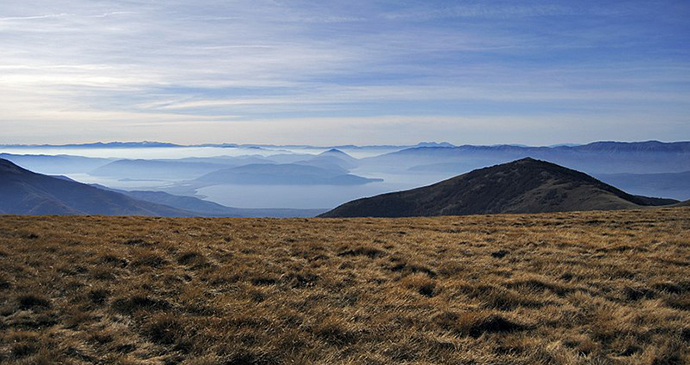
Brajčino offers beautiful views over both major and minor Prespa lakes © Ptahhotep, Wikimedia Commons
Brajčino
The traditional village of Brajčino, perched on the edge of Pelister National Park less than 5km from the border with Greece, can claim to be the first ecotourism initiative in North Macedonia. Pristine and picturesque, it has an idyllic location away from the hustle and bustle of city life, and is protected by the Baba massif, with a view on to Lake Prespa. It offers good access to the glacial lakes atop the range and from there to Pelister summit and the mountain huts. It is easily accessible by car, or by bus from Bitola (two daily) or Resen (several daily). It is also the starting point for the longer day or overnight hike to Hotel Molika via Pelister National Park.
Formerly a rich trading village, Brajčino still has a small population of mixed ages despite the emigration of many of the villagers in the middle of the 20th century to Canada and Scandinavia due to a lack of employment or in order to escape communist persecution. However, the departure of most of the business know-how from the village has left it in hard times, even more so since the break-up of Yugoslavia which has taken its toll on the village’s formerly prosperous apple trade. Previously, apples from the area would be sold as far away as Zagreb and Ljubljana, whereas new borders and taxes have all but eliminated the apple export. Today, the villagers, through the help of Swiss funding and the local non-governmental organisations of DEM (Ecological Movement of Macedonia) and BSPM (Bird Society Protection of Macedonia), are reviving the local economy by offering visitors access to their pristine lifestyle in return for keeping it so. Ten percent of the income of the guides, accommodation and the village shop is reinvested into preserving the local area.
About 3km before the road arrives at Brajčino, it weaves through Ljubojno, a larger village comprising a similar style of traditional stone houses, together with a few 19th- and 20th-century town houses on the central square. Clearly seen above the village are the two churches of Sv Petka and Sv Pavle, which vigilantly watch over Ljubojno.
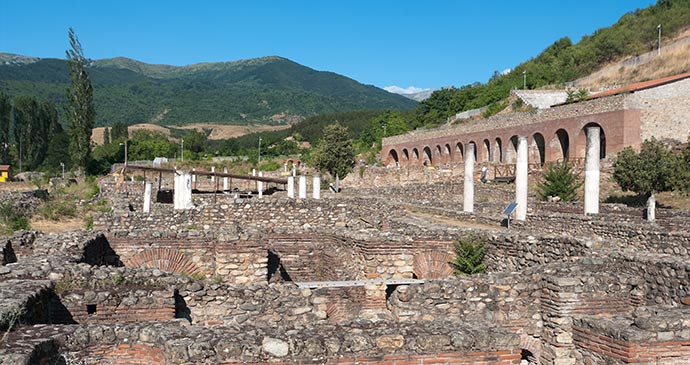
This impressive Roman archaeological site lies on the southern outskirts of Bitola © ollirg, Shutterstock
Heraklea Linkestis
Founded by Philip II in the 4th century BC and an active centre of trade for another eight centuries afterwards, this once-significant town on what is now the southern outskirts of Bitola rivals Stobi as the most worthwhile Roman-era archaeological site in North Macedonia. Only a small part of the old town has been uncovered and excavated, so visits in future years should prove ever more fruitful, especially as historical records show that there are still a number of houses and tombs of the rich and famous at the time to be found. Several important relics and buildings have already been uncovered including the amphitheatre, baths, basilicas and some impressive mosaics, only some of which are on show in the summer. There is a small museum, a snack and drink shop, and a souvenir shop with books on the site in English available for sale. Most of the more important statues are on display in the town museum or in the National Museum in Skopje.
The site lies about 2.5km south of the town centre, a 25–30-minute walk depending on where you start. To get here, follow the pedestrianised Maršal Tito Street south across Partizanski and through Bitola Park until you reach a T-junction in front of a car park. Turn left here, then continue for 100m to another T-junction where you need to turn right on to Ivo Lola Ribar Street. Shortly after this, immediately past the Belcom supermarket, turn right on to the (indistinctly signposted) 500m feeder road that leads to the archaeological site. If you don’t feel like the walk, a taxi shouldn’t cost more than 100MKD.
Considerable archaeological work continues here every year, and for those who wish to take part, the Balkan Heritage School has organised volunteer workshops here in recent years.
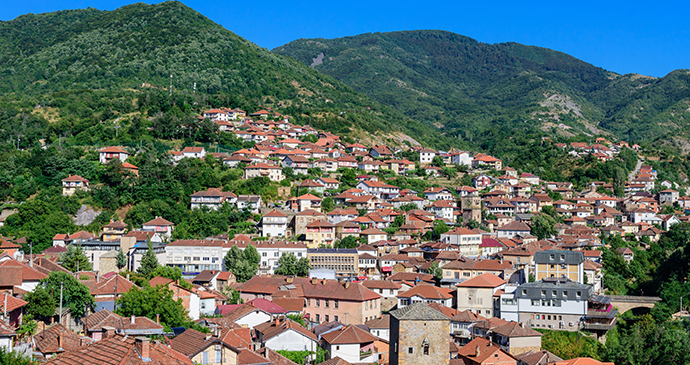 Not to be missed is the scenic small town of Kratovo, which is nestled in an extinct volcanic crater © Thomas Dekiere, Shutterstock
Not to be missed is the scenic small town of Kratovo, which is nestled in an extinct volcanic crater © Thomas Dekiere, Shutterstock
Kratovo
Midway between the start of the E871 (Highway 2) at Kumanovo and Kriva Palanka is the turn-off for Kratovo and Probištip, which joins Highway 2 to Highway 27. On this road, deep in the belly of an ancient and burnt-out volcanic crater, is the small village of Kratovo, a great base to explore this little-visited but fascinating region of North Macedonia.
In Roman times this mining town was known as Kratiskara, meaning ‘crater’, and variations of its name, Koriton and Koritos in Byzantine times, have centred around this meaning. The crater-like hollow of the village has demanded high-arched bridges to cross the river and ingenious architecture to scale the steep ravine. The difficulty of getting to Kratovo has also left the town relatively free of communist concrete. Six defensive towers hark back to the time of King Karpoš. At its commercial peak in the 19th century, Kratovo was reputedly the only town in North Macedonia to support distinct but harmonious Orthodox, Catholic, Muslim and Jewish communities, each of which had its own quarter – these are still recognised today, though boundaries have blurred in recent decades.
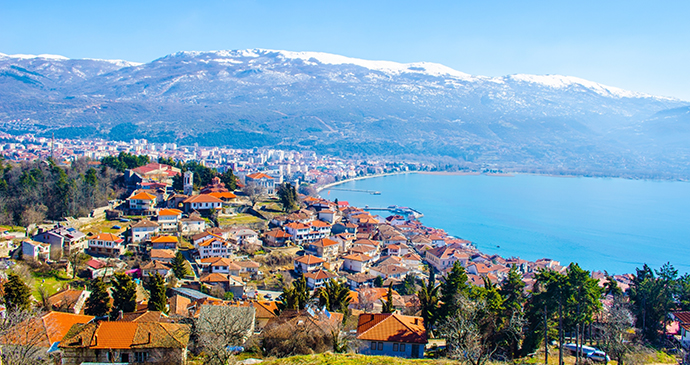
Ohrid boasts a memorable setting on a hilly peninsula lapped by a calm aquamarine lake © trabantos, Shutterstock
Lake Ohrid
Ohrid is the jewel of the Macedonian crown. Both the lake and town of that name form part of the country’s only UNESCO World Heritage Site, which was inscribed as a mixed natural and cultural property in 1997 in recognition of its rare environmental and historical significance. And not without reason. The oldest continuously existing lake in Europe, Ohrid formed in a geotectonic depression around five million years ago, placing it in the same ranks of antiquity as lakes Baikal (Russia), Tanganyika (East Africa) and Titicaca (Peru/Bolivia). Extending over 358km², it is the deepest lake in the Balkans, with a maximum depth of 288m, and some scientists regard it as the world’s most biodiverse water body of comparable size, hosting more than 200 endemic species, most famously the heavily fished Ohrid trout (Salmo letnica).
The lake’s principal port town, also called Ohrid, sprawls picturesquely across the hilly northeastern shore. One of the oldest continuously occupied towns in Europe, with roots going back to Neolithic times, it’s renowned for the old churches and traditional architecture that characterise its atmospheric old town. The most important tourist focus on the lake, the town is serviced by a large and varied selection of hotels, restaurants and other amenities catering to domestic and foreign visitors alike. And although it can get very busy during July and August and over long weekends, the old town is much quieter and cheaper on weekdays and out of season.
Enclosed on all sides by pretty green mountains whose peaks are brushed white with snow in winter, Lake Ohrid is noted for its beaches and transparent clean blue water, which offer ideal swimming conditions in the warm Balkan summer, as well as some great diving and sailing opportunities. Points of interest include the little-visited but quaint port town of Struga on the northern shore, the historic Monastery of Sv Naum and associated lake springs near the Albanian border, the tiny cave churches at Kališta and Radožda, and tranquil lakeshore villages such as Trpejca, Peštani and Lagadin. Lake Ohrid is also the obvious base from which to make day trips by jeep, donkey or foot to the characterful old mountain villages of Oktisi and Vevčani, or to go caving, hiking and paragliding in the scenic Galičica National Park.
Monospitovo Wetlands
For an authentic off-the-beaten-track experience, make a stop at the Monospitovo Blato near Monospitovo village, itself an authentic rural village where time seems to have stood still. The Blato, as it’s affectionately known by its nearby residents, is a marsh, purported to be one of the last and biggest in North Macedonia. It lies sprawled at the base of Mount Belasica, 17km southeast of Strumica, and has been officially designated as an environmentally protected site, conferring upon it the status ‘monument of nature’.
Monospitovo Blato lies between Bansko and Kolešino in the municipality of Bosilovo. To get here take the road to Bansko and Murtino, and at Murtino turn east towards Monospitovo village; the entrance to the wetlands lies to the south of the village. In Bosilovo itself, a good place to eat is at Pizzeria Park, which is famous for its bosilanka deep-pan pizza, made with pork, or with chicken and vegetables, and served with a delicious tomato sauce on the side.
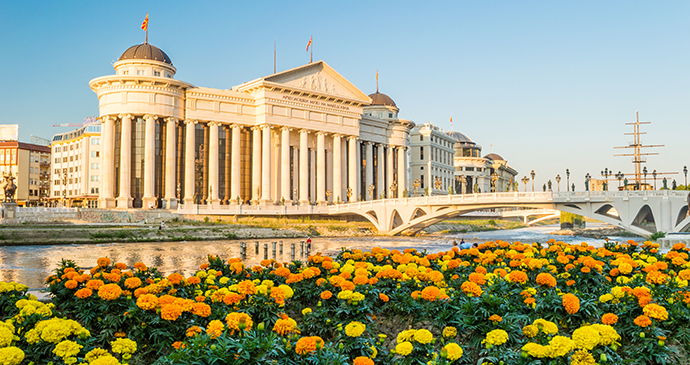 Housed within one of Skopje’s most impressive buildings, the Archaeological Museum of Macedonia shares its home with the Supreme Court and National Archives © Andrii Lutsyk, Shutterstock
Housed within one of Skopje’s most impressive buildings, the Archaeological Museum of Macedonia shares its home with the Supreme Court and National Archives © Andrii Lutsyk, Shutterstock
Skopje
The capital of North Macedonia and main port of entry to the country, Skopje is an up-and-coming city whose population of 550,000 represents more than a quarter of the national total. It boasts a strategic location on the River Vardar and has been an important centre of regional trade for several millennia, as evidenced by the presence within the city limits of archaeological sites dating back to Neolithic, Roman and Ottoman times. The Vardar divides Skopje into a predominantly Muslim northern half and predominantly Orthodox Christian southern half. Most government offices, hotels and shopping malls can be found south of the river, along with the railway station and main intercity bus station.
A city of many cultures, Skopje is worth at least a couple of days’ exploration. The main attraction is the old Turkish quarter known as Čaršija, which lies to the north of the river below the imposing Kale Fortress, and houses a large daily bazaar, several Ottoman architectural landmarks, and a small but buzzing café and nightlife scene. The city also boasts a varied selection of museums, art galleries and archaeological sites, ranging from the recently opened Archaeological Museum of Macedonia and Holocaust Memorial Centre to the Roman-era ruins at Skupi and reconstructed Neolithic village of Tumba Madžari. Further afield, don’t miss out on the cable car up Mount Vodno, the rare Byzantine frescoes in the 12th-century Church of Sv Pantelejmon, and the spectacular lake set within the sheer cliffs of the Matka Canyon.
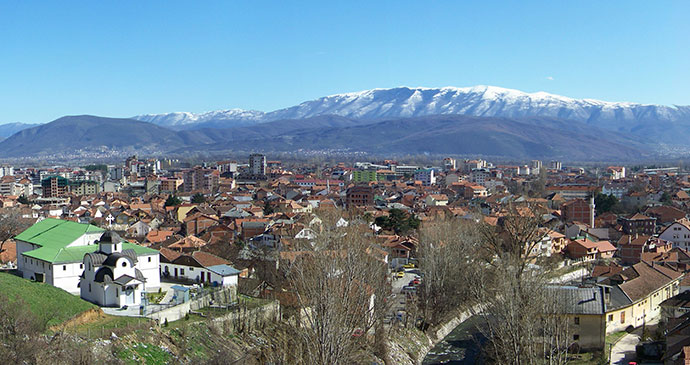
A visit to the lovely town of Tetovo offers the opportunity to take in some stunning mountain scenery © vesnickamarkoska, Flickr
Tetovo
Bisected by the Pena River some 40km west of Skopje, Tetovo is a substantial and lively university town with an estimated population of 70,000. The atmospheric old town, flanking the Pena, is lined with jewellery shops, old-fashioned tailors and boutiques selling modern and traditional clothes, and it also houses a museum and art gallery, and a number of historic mosques and churches, most famously the colourful 15th-century mosque known as Šarena Džamija. Other worthwhile historical sites in Tetovo include the well-tended complex of early 19th-century Islamic buildings known as Arabati Baba Bektaši Teke, and an impressive hilltop fort.
Tetovo is also the gateway to the Šar Mountains and to the popular Popova Šapka ski resort. Towering above the town, covered in snow until July and as early as September, is North Macedonia’s second highest mountain, Titov Vrv (Tito’s Summit, 2,748m). This is in fact the highest mountain that lies completely in North Macedonia; the higher peak of Mount Korab (2,764m) lies further to the south above Lake Mavrovo on the border with Albania.
Nestled close to Kosovo and Albania, Tetovo is the de facto capital of North Macedonia’s significantly sized Albanian minority. It is also the headquarters of the main Albanian-centred political parties, the Democratic Union of Integration and the Democratic Party of Albanians. Just outside Tetovo is the South East European University, North Macedonia’s third-largest university after Skopje and Bitola.
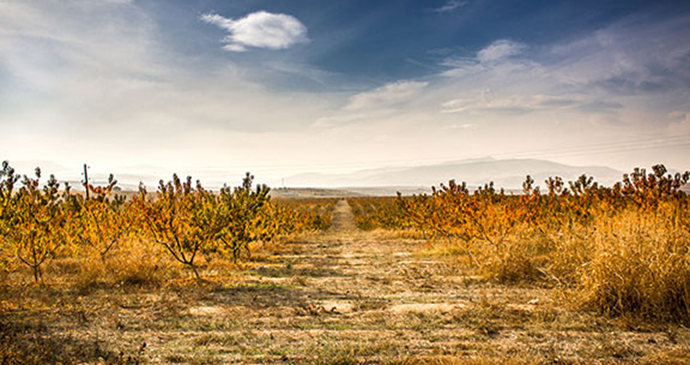
The rich Tikveš Plain is an area renowned throughout North Macedonia for its fabulous wine © Marjan Lazarevski, Flickr
Wines of the Tikveš Plains
The entire course of the Vardar Valley from Veles all the way south to Thessaloniki is fertile grape-growing country, and within North Macedonia the Tikveš Plain around Negotino, Kavadarci and Demir Kapija produces some of the country’s best wines. There are more than 50 small private wineries in North Macedonia and the number is growing, as is the quality. A visit to one of the vineyards in September and October or around Sv Trifun Day in February is always well worth the time if you’d like to try out the season’s newest, or the best of last year’s stock.
Near Demir Kapija, the former boutique vineyard Popova Kula is well worth a visit or overnight stay at any time of year, and you might also want to pop into the historic Royal Winery Queen Maria. Kavadarci is home to the massive Tikveš Winery, while Negotino boasts nine vineyards in its vicinity. There are also vineyards further north around Skopje, and you’ll find the local wines of smaller vineyards served in plastic bottles and cardboard cartons at local petrol stations and stores.
Macedonian wines are unique in European for being made with very little, if any, additional sugar or sulphite preservatives. They are preserved, therefore, mostly by the grapes’ own natural sugars and it is for this reason that almost all Macedonian wines are dry rather than sweet, and why you won’t get such a big hangover the next day after drinking a bottle of T’ga za Jug (Longing for the South) or Alexandria.
Related books
For more information, see our guide to North Macedonia:
Related articles
From boiling lakes to vast alpine bodies of water, these are our favourite lakes from around the world.
North Macedonia might not necessarily be on your list of European destinations to visit, but it certainly should be.
We’ve all heard of Burgundy and Tuscany, but what about Kosovo and Israel?
From large lakeside complexes to tiny clifftop churches, North Macedonia is home to some of the best monasteries in Europe.
From stunning landscapes to sites of historical and cultural importance, monasteries provide a wealth of interest for the avid traveller.
There are many national parks in Europe that remain fairly unknown. Here you can discover 14 of the best. Why miss out on visiting somewhere spectacular?
